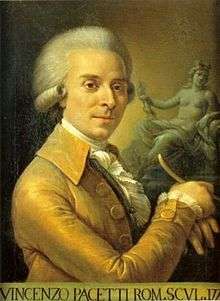Vincenzo Pacetti
Vincenzo Pacetti (1746–1820) was an Italian sculptor and restorer[1] from Castel Bolognese, particularly active in collecting and freely restoring and completing classical sculptures such as the Barberini Faun (1799 – now in the Glyptothek, Munich)— his most famous work— the Hope Dionysus (now in the Metropolitan Museum of Art[2]) and the Athena of Velletri (1797 – now in the Louvre) and selling them on to rich collectors as finished artefacts. He was the brother of Camillo Pacetti.
Vincenzo Pacetti | |
|---|---|
 | |
| Born | 1746 |
| Died | 1820 |
| Nationality | Italian |
Biography
Vincenzo Pacetti was born in 1746. He studied at the Accademia del Nudo and then trained in the studio of the sculptor-restorer, Pietro Pacili, 1766–72, taking over Pacili's studio at the elder sculptor's death.
As an independent sculptor he was accepted into the Accademia di San Luca, presenting his portrait (illustration) and serving as director, a testament to his reputation. Bartolomeo Cavaceppi, another leading sculptor-restorer esteemed Pacetti enough to make him executor of his will.[3]
From the Barberini, Pacetti was promised the purchase of a cache of Roman sculptures and fragments in 1799, among which prominently figured the Barberini Faun. He removed earlier restorations and sculpted a new right leg in marble, but the members of the Barberini family withdrew their offer of sale, and Pacetti was reimbursed the sum of 2000 zecchini.[4]
As the favoured sculptor-restorer for Prince Marcantonio Borghese, he also produced many reliefs and stucchi on mythological themes for the Sala degli Imperatori (of which "The goat Amanthea" and "Perseus freeing Andromeda" are most notable) and the room housing Bernini's Aeneas and Anchises and Apollo and Daphne, both at the Galleria Borghese.[5] Other works of his are in San Salvatore in Lauro, Santo Spirito in Sassia, Santi Michele e Magno, and the Palazzo Carpegna.
In the latter end of his career his most important patron was Lucien Bonaparte, for whom he supplied plaster casts of famous antique sculptures for his villa at Canino.[6]
He died in Rome. His diary covering the years 1773–1803,[7] and correspondence are important primary resources for the Roman art market of his day.[8]
Further reading
- I. Bignamini, C. Hornsby, Digging And Dealing In Eighteenth-Century Rome (2010), p. 310–312
- N. H. Ramage, 'The Pacetti papers and the restoration of ancient sculpture in the 18th century', in Von der Schonheit Weissen Marmors: Zum 200 Todestag Bartolomeo Cavaceppis, ed. T. Weiss (1999. Mainz), p. 79–83
- H. Honour, 'The Rome of Vincenzo Pacetti: leaves from a sculptor's diary', in Apollo; 78 (1963 November), 368–376
- H. Honour, 'Vincenzo Pacetti', in The Connoisseur; 146 (1960 November), p. 174–181
Notes
- Pacetti as sculptor is discussed by Hugh Honour, "Vincenzo Pacetti", Connoisseur, 46 (1960:174ff, and as restorer by Nancy H. Ramage, "Restorer and Collector: Notes on Eighteenth-Century Recreations of Roman Statues", Memoirs of the American Academy in Rome. Supplementary Volume 1, The Ancient Art of Emulation: Studies in Artistic Originality and Tradition from the Present to Classical Antiquity (2002:61–77).
- Ramage 2002:68.
- Ramage, in relating this observes that Antonio Canova's Perseus, executed about the same time cost 3000 zecchini, only 1000 more.
- The genesis of the latter room as remade by the architect Antonio Asprucci (1723–1808) and Pacetti's role were discussed in detail by Alvar González-Palacios, "The Stanza di Apollo e Dafne in the Villa Borghese", The Burlington Magazine 137 No. 1109 (August 1995:529–549); most of the completions to antique sculptures in the Borghese collection effected by Pacetti have been removed in the Louvre Museum, and Nancy Ramage (2002:70) notes that the Munich Glyptothek has removed Pacetti's leg and left arm from the Barberini Faun.
- Ramage 2003:70f and notes, 74.
- In Biblioteca Alessandrina, Rome, MS 321.
- Hugh Honour, "The Rome of Vincenzo Pacetti: leaves from a sculptor's diary", Apollo 78 (1963:368ff).; Nancy H. Ramage, "The Pacetti papers and the restoration of ancient sculpture in the 18th century", Von der Schönheit, no. 5 (79–83).
Sources
- Italian artists (in Italian)
- Nancy Ramage, "Vincenzo Pacetti and Luciano Bonaparte: The Restorer and his Patron," in Janet Burnett Grossman, Jerry Podany, and Marion True (ed.s), History of Restoration of Ancient Stone Sculptures (The Getty Museum, 2003).Archived April 19, 2012, at the Wayback Machine